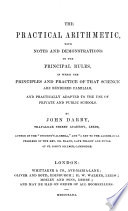 | Ferdinand Rudolph Hassler - 1826 - 232 sider
...given, to find the number of terms. When the first term is subtracted from the other term given, we have the product of the common difference into the number of terms less one as re J mainder; dividing this therefore by the common difference, we have the number of the term,... | |
 | Jeremiah Day - 1827 - 352 sider
...^=a^- (n— l)Xd; that is, 425. In an arithmetical progression, the last term is equal to the first, + the product of the common difference into the number of terms less one. Any other term may be found in the same way. For the series may be made to stop at any term, and that... | |
 | Jeremiah Day - 1831 - 354 sider
...z=a.\-(n — l) xd; that is, 425. In an arithmetical progression, the last term is equal to thefirst,-\- the product of the common difference into the number of terms less one. Any other term may be found in the same way. For the series may be made to stop at any term, and that... | |
 | Charles Davies - 1833 - 284 sider
...number of terms, and add the first term to the product. Hence we have CASE I. § 225. Having given the first term, the common difference, and the number of terms, to find the last term. RULE. Multiply the common difference by 1 less than the number of terms, and to the product add the... | |
 | Francis Walkingame - 1833 - 204 sider
...tujind the less extreme. , RULE. Divide the sum by the number of terms : from the quotient subtract half the product of the common difference into the number of terms less 1 ; and the remainder will be the less extreme. (10) A man is to receive £360. at 12 several payments,... | |
 | 1836 - 488 sider
...they form a descending series. In an arithmetical progression, the last term is equal to the first, + the product of the common difference into the number of terms less one. In an ascending series, the first term is the least, and the last the greatest. In a descending series,... | |
 | Charles Davies - 1838 - 292 sider
...than the number of terms, and add the first term to the product. Hence, we have CASE I. Having given the first term, the common difference, and the number of terms, to find the last term. RULE. Multiply the common difference by 1 less than the number of terms, and to the product add the... | |
 | George Roberts Perkins - 1841 - 274 sider
...number of terms is 48, and the sum of all the terms is 38496. What is the last term ? CASE XI. Given the first term, the common difference, and the number of terms, to find the sum of all the terms. RULE. To twice the first term, add the product of the common difference into... | |
 | Charles DAVIES (LL.D.) - 1843 - 348 sider
...than the number of terms, and add the first term to the product. Hence, we have CASE I. Having given the first term, the common difference, and the number of terms, to find the last term. RULE. Multiply the common difference by 1 less than the number of terms, and to the product add the... | |
 | John Darby (teacher of mathematics.) - 1843 - 236 sider
...to exceed the former by 2d. What will her first payment be ? Ans. 3d. PROBLEM V. — Given the least term, the common difference, and the number of terms to find the greatest term. RULE. — Multiply the number of terms by the common difference, to this product add... | |
| |